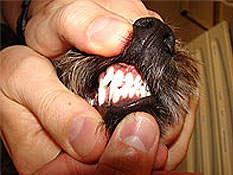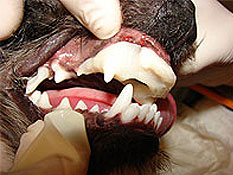Specialties
AnesthesiaAvian and Exotics
Cardiology
Clinical Pathology
Dentistry and Oral Surgery
Dermatology
Emergency & Critical Care
Integrative Medicine
Internal Medicine
Medical Oncology
Neurology
Ophthalmology
Orthopedics
Radiation Oncology
Radioiodine (I-131)
Radiology
Rehabilitation & Pain Management
Surgery
Theriogenology
Canine Orthodontics (Doggie Braces)
Orthodontics for a dog whose bite was worse than her bark
Misty, a 7-month-old Cairn Terrier, presented for evaluation of abnormal mouth movements. Awake oral examination revealed abnormal positioning of the right lower canine tooth which was preventing full closure of the mouth due to contact with the roof of the mouth. If not treated, the malocclusion would result in abnormal wear of the teeth. Also, a defect in the palate (an oronasal fistula) can occur due to chronic trauma caused by the malpositioned tooth.
Options for treatment include 1) extraction of the malpositioned tooth, 2) crown reduction of the canine tooth and vital pulp therapy of the tooth under sterile conditions, or 3) placement of an orthodontic device. Extraction is the least desirable option since this tooth makes up such a large portion of the lower jaw. Misty's owner opted for placement of an inclined plane passive orthodontic device to move the tooth to a proper position.
Whenever an orthodontic abnormality is diagnosed, the ethical aspects of treatment must be discussed. Orthodontic conditions often show breed predilections, suggesting a genetic component. Therefore, we recommend spaying or neutering before, or at the time of, the orthodontic procedure.
In Misty's case, the right upper third incisor required extraction to make space for the larger, more functionally important right lower canine tooth. Then a plastic composite material was used to fabricate a "sliding board" to allow for gradual movement of the canine tooth to a more normal position.
The device engages the mandibular canine teeth, when the mouth is nearly closed, resulting in slow, lateral movement of the canine teeth, guiding the tooth to its normal space. This device requires good home care (brushing to keep the device clean) and may become dislodged if dogs are allowed to chew on hard items while the device is in place. The device may be kept in the mouth as a retainer once the teeth have moved to their desired position, or a retainer may be placed between the mandibular canine teeth to prevent drifting of the teeth back to their original position.
This technology relieved Misty's uncomfortable bite by moving the malpositioned canine tooth, while avoiding extraction of this functionally important tooth. Misty's bite is now as good as her bark!















